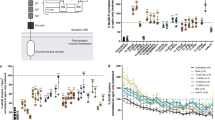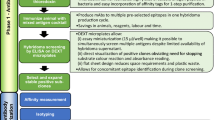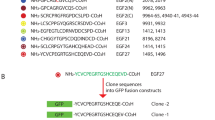Abstract
Recently1 we described a procedure for preparing antibodies to the acetylcholine receptor (AChR) based on immunoglobulin idiotypes and on the hypothesis that, regardless of functional differences, macromolecules of the same specificity will show structural homologies in their binding sites. Antibodies were prepared in rabbits to a structurally constrained agonist of AChR, trans-3,3′-bis[α-(trimethylammonio)methyl]azoben-zene bromide (BisQ)2,3. These antibodies mimicked the binding specificity of AChR in its activated state4—agonists were bound with affinities that were in accord with their biological activities and antagonists were bound poorly. Rabbits were then immunized with a specifically purified preparation of anti-BisQ to elicit a population of antibodies specific for the binding sites of anti-BisQ. A portion of the anti-idiotypic antibodies5,6 produced in the second set of rabbits cross-reacted with determinants on AChR preparations from Torpedo californica, Electrophorus electricus and rat muscle. Moreover, several of the rabbits showed signs of experimental myasthenia gravis, in which circulating AChR antibodies are typically found. To devise a more direct route to monoclonal anti-receptor antibodies we based our strategy on acceptance of the concept of the anti-idiotypic5,6 network theory of Jerne7. According to this theory, injection of an antigen elicits, in addition to antibodies to the antigen, other populations that include anti-idiotypic antibodies directed at the combining sites of the antigen-specific antibodies. If the antigen-specific antibodies recognize a ligand of a receptor, then the anti-idiotypic antibodies should bind receptor. Thus, when a mouse is immunized with a bovine serum albumin conjugate of BisQ (BisQ–BSA)1, it should be possible to expand populations of spleen cells that secrete antibodies which bind anti-BisQ and AChR, in addition to populations specific for BisQ. Fusion of the spleen cells with an appropriate myeloma line should yield monoclonal anti-AChR antibodies. Here we report the success of this approach and its implications.
This is a preview of subscription content, access via your institution
Access options
Subscribe to this journal
Receive 51 print issues and online access
$199.00 per year
only $3.90 per issue
Buy this article
- Purchase on Springer Link
- Instant access to full article PDF
Prices may be subject to local taxes which are calculated during checkout
Similar content being viewed by others
References
Wassermann, N. H. et al. Proc. natn. Acad. Sci. U.S.A. 79, 4810–4814 (1982).
Bartels, E., Wassermann, N. H. & Erlanger, B. F. Proc. natn. Acad. Sci. U.S.A. 68, 1820–1823 (1971).
Wassermann, N. H., Bartels, E. & Erlanger, B. F. Proc. natn. Acad. Sci. U.S.A. 76, 256–259 (1979).
Heidmann, T. & Changeux, J.-P. A. Rev. Biochem. 47, 317–357 (1978).
Oudin, Y. & Michael, M. C.r. hebd. Séanc. Acad. Sci., Paris 257, 805–808 (1963).
Kunkel, H. G., Mannick, M. & Williams, R. C. Science 140, 1218–1219 (1963).
Jerne, N. K. Annls Inst. Pasteur, Paris 125C, 373–389 (1974).
Kearney, J. F., Radbruch, B. L. & Rajewsky, K. J. Immun. 123, 1548–1550 (1979).
Köhler, G. & Milstein, C. Nature 256, 495–497 (1975).
Sharon, J., Morrison, S. L. & Kabat, E. A. Proc. natn. Acad. Sci. U.S.A. 76, 1420–1424 (1979).
Cleveland, W. L., Sarangarajan, R. & Erlanger, B. F. J. immun. Meth. (submitted).
Schechter, Y., Maron, R., Elias, D. & Cohen, I. R. Science 216, 542–544 (1982).
Geha, R. S. J. Immun. 129, 139–144 (1982).
Binion, S. & Rodkey, L. S. J. exp. Med. 156, 860–872 (1982).
Tzartos, S. J., Seybold, M. E. & Lindstrom, J. M. Proc. natn. Acad. Sci. U.S.A. 79, 188–192 (1982).
Fulpius, B. W., Lefvert, A. K., Cuenoud, S. & Mourey, A. Ann. N. Y. Acad. Sci. 377, 307 (1981).
Rees-Smith, B. & Hall, R. Lancet ii, 427 (1974).
Author information
Authors and Affiliations
Rights and permissions
About this article
Cite this article
Cleveland, W., Wassermann, N., Sarangarajan, R. et al. Monoclonal antibodies to the acetylcholine receptor by a normally functioning auto-anti-idiotypic mechanism. Nature 305, 56–57 (1983). https://doi.org/10.1038/305056a0
Received:
Accepted:
Issue Date:
DOI: https://doi.org/10.1038/305056a0
This article is cited by
-
Lupus autoantibodies interact directly with distinct glomerular and vascular cell surface antigens
Kidney International (1996)
-
A comparison of the anti‐idiotypic responses generated by antibodies to a protein and a hapten: A common interspecies idiotype on antibodies against human albumin induces an idiotypic network in rabbits
Immunology & Cell Biology (1996)
-
Carboxyl terminal sequences of ?-tubulin involved in the interaction of HMW-MAPs. Studies using site-specific antibodies
Molecular and Cellular Biochemistry (1994)
-
Mimicking ligands
Nature (1993)
-
1. Antibodies with N-choline receptor recognition characteristics immunochemical modeling of ligand-receptor reactions
Pharmaceutical Chemistry Journal (1992)
Comments
By submitting a comment you agree to abide by our Terms and Community Guidelines. If you find something abusive or that does not comply with our terms or guidelines please flag it as inappropriate.



